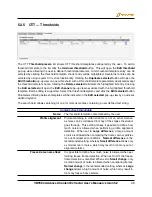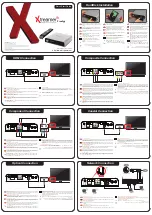
Scrambling:
Each stream can be configured to raise an alarm when that
stream’s scrambling status changes. The default behavior
is to ignore whether a stream is scrambled or not. In order
to trigger an alarm if a clear service is received when it is
supposed to be scrambled, select Error if not scrambled in the
Scrambling pull-down menu. For a multicast each individual
service will be checked for violation of this setting — i.e. each
service may trigger an alarm.
As a general rule the value of the Scrambling pull-down
should be set to Ignore when individual service scrambling
alarm handling is defined.
Scrambling detection mode:
When scrambling detection mode is set to ‘Both’, scrambling
of a stream is detected by checking the control bit of the
MPEG transport stream packets and checking PES sync. If
one or both checks indicate that the scrambling requirement
is not fulfilled, an alarm will be raised. When ‘Control bit’ or
‘PES sync’ is selected, scrambling detection will rely on the
selected parameter only.
Scrambling error seconds:
The number of seconds a scrambling error should persist
before an alarm is raised. The default setting is to wait until
the error has lasted for 40 seconds. This is useful when
scrambling alternates between scrambled and unscrambled
and you don’t want to raise an alarm every time the stream is
not scrambled but only when there is a real error.
Freeze-frame noise floor:
Picture matching in video streams is not an exact science,
as noise can be introduced in many of the stages the stream
goes through. This setting makes it possible to define how
much noise is allowed when performing freeze-frame detec-
tion.
When set to Off, the freeze-frame detection is disabled. When
set to Small change, only a small amount of noise is al-
lowed when comparing frames. Normal change is the recom-
mended setting, whereas Large change allows a high amount
of noise, which may result in too many freeze-frame alarms.
Freeze-frame error timeout:
The time (in minutes) a freeze-frame error should persist
before the Extractor will raise an alarm
Color-freeze noise floor:
It is possible to define how much noise is allowed when
performing color-freeze detection. When set to Off, the color-
freeze detection is disabled. When set to Small change, only
a small amount of noise is allowed when comparing to the list
of solid colors. Normal change is the recommended setting,
whereas selection of Large change allows a high amount of
noise, which may result in too many color-freeze alarms.
VB7880 Advanced Content Extractor User’s Manual version 5.2
59
















































